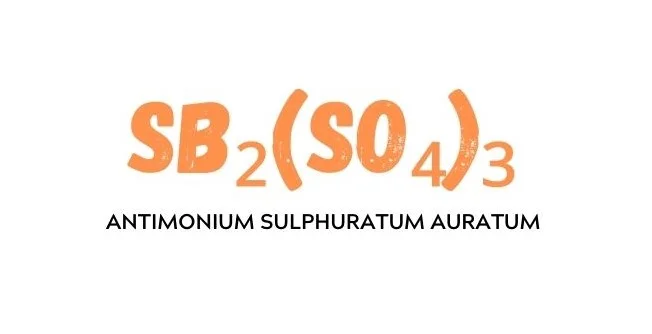Explore the healing potential of Antimonium Sulphuratum Auratum, sourced from the Golden Sulphuret of Antimony.
This remedy, available in the second or third trituration, has shown efficacy in addressing various health concerns, particularly those related to the nose and throat, respiratory system, and skin.

SOURCE INFORMATION
- Golden Sulphuret of Antimony.
- “Golden Sulphuret of Antimony” refers to a compound known as antimony trisulfide (Sb2S3).
- This substance is a sulfide of antimony, where antimony is bonded with three sulfur atoms.
- The term “golden” is used to describe its characteristic golden or yellowish color.
Chemical Composition
- Antimony Trisulfide (Sb2S3): It is composed of two antimony atoms bonded with three sulfur atoms.
Appearance
- Color: Golden yellow to brownish-black.
Properties
- Crystal System: Typically crystallizes in the orthorhombic system.
- Density: It is a relatively dense compound.
- Luster: Metallic luster.
- Solubility: Insoluble in water.
Read a detailed post on ALL ABOUT HOMOEOPATHIC MEDICINES by following the link.
CHIEF GUIDING SYMPTOMS
1. Nose and Throat
- Nosebleed on washing, increased secretion in the nose and throat.
- Rough and scrapy feeling, loss of smell.
- Metallic styptic taste.
2. Respiratory
- Tickling in the larynx, increased mucus in bronchi.
- Difficulty in respiration, bronchial pressure, and constriction.
- Tough mucus in bronchi and larynx, dry hard cough.
- Congestion of upper lobe of the left lung.
- Effective in winter coughs, with generalized soreness.
- Useful in pneumonia with hepatization and failed resolution.
3. Skin
- Addresses acne, especially the pustular variety.
- Itching on hands and feet.
DOSAGE
- Administer in the second or third trituration.
FAQs (Frequently Asked Questions)
What conditions does Antimonium Sulphuratum Auratum target?
- It is effective for chronic nasal and bronchial catarrh, acne, and amaurosis.
What are the notable symptoms related to the nose and throat?
- Nosebleed on washing, increased secretion, rough feeling, loss of smell, and a metallic styptic taste.
How does it impact the respiratory system?
- Addresses tickling in the larynx, increased mucus, difficulty in respiration, and tough mucus in bronchi and larynx.
Is it beneficial for skin conditions?
- Yes, it is known for treating acne, particularly the pustular variety, and relieves itching on hands and feet.
